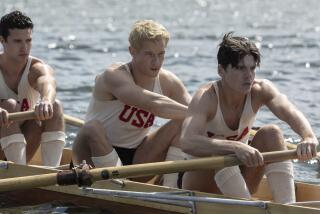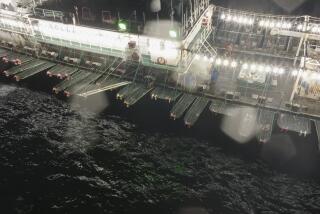Around the World Sailboat Race : For 6 of 25 Starters, Itās Been a Cruel Sea
NEWPORT, R.I. ā Six boats, out of 25 starters, are effectively out of the solo around-the-world sailboat race.
One, Airforce, sank. Another, Quailo, has officially withdrawn, and whether two others, Madonna and Miss Global, keep racing is in doubt. All four are Class 2 boats, 40 to 50 feet long.
Two Class 1 boats, 50 to 60 feet, remain in the BOC Challenge but are out of contention.
Australiaās ACI Crusader is speeding down the South Atlantic, trying to join the 19-boats that are in Cape Town preparing for Saturdayās restart.
New Zealandās Neptune Express remained in Recife, Brazil, at midweek while skipper Richard McBride made final adjustments to a mainsail that did not fit his new mast, a replacement for the spar lost at the Equator Sept 23.
Neither boat can reach Cape Town in time to start with the fleet. But each has an excellent chance of catching up in Sydney. Winning the race, however, is out of the question. They will undoubtedly remain a month behind the leaders in total elapsed time as they circle the globe.
The first leg is proving to be the real qualifier for this 27,000-nautical mile race.
Each boat undertook a 2,OOO-mile qualifying sail to get into the race. But that is hardly enough to test man and boat and weld the two into a competitive unit.
āIt takes three to four years to really know a boat,ā South Africaās Bertie Reed said after arriving in Cape Town aboard Stabilo Boss, his last-minute entry. His boat is the former Disque DāOr, an around-the-world-race veteran--but in races with a full crew on board.
Solo ocean racing takes more than knowing a boat.
An ocean sailor is by definition a navigator, but his electronic satellite navigation device (satnav) will give him his position and heading for his destination with the press of a button. If that electronic marvel fails, however, heās back with Columbus and the sun and stars.
Mark Schraderās satnav aboard Lone Star failed at the start. Schrader, 39, of Stanwood, Wash., navigated with a sextant all the way to Cape Town.
Meteorologist, mechanic, electrician, electronics technician, the solo sailor also must have patience and determination. And he has to be able to sew.
If heās moody, the mood had better be up, otherwise fickle winds and sea will drive him to despair.
Above all, the solo racer must be capable of long-term commitment.
The days stretch into weeks. The single-hander is in the center of a dome of sky on a saucer of sea. The outside world is a crackle on the radio or, rarely, a ship on the horizon.
His days are endless hours of sail adjustment and equipment repair, tracing an electrical short, sewing a split seam in a sail, hunting for a screw, a bolt or a part that is known to be on board but which eludes every effort at discovery.
Of more hours hunched over his chart and a weather facsimile map. Where is the wind? Will it be there when he gets there? Or will it have shifted?
Is that tropical depression going to grow up to be a hurricane? Is that windless high pressure cell going to slip east or west; does he dare await the shift before altering course? Or will it be too late then?
Should he dog the track of the boat ahead, or gamble on a different heading that could put him ahead? Or cost him the lead.
The solo sailor lives with constant anxiety.
Will the engine start? If it doesnāt, how will the batteries be charged, the radio continue to function, the autopilot to steer the boat?
Pentti Salmi, 39, a garrulous Finn aboard the 44-foot Colt by Rettig, lost his engine in an electrical fire. His water-driven generator failed at the same time. He couldnāt fix the engine, but he got the water generator working by using a piece of sardine can as a spare part.
Mac Smith, 55, of Ormond Beach, Fla., discovered the meaning of anxiety when his 44-foot Quailo rolled and, he thinks, pitch-poled end over end in the South Atlantic. He came back up to find the mast bent into an āSā, stainless steel fittings snapped and gaping holes in the mast where support fittings were ripped out.
His anxiety ended in Rio where, after surveying the damage, examining his checking account and looking at the calendar, he notified race headquarters that he was out of the race.
Anxiety is having your rudder fail--twice, as it did to Edouardo Louro de Almeida, 26, of Brazil aboard Miss Global. Then, after repairs in Recife, Brazil, and putting to sea again, he discovered that his keel may be loose. Course is altered for Rio and probable withdrawal.
Also in Rio with rigging and steering problems on his 48-foot Madonna is Japanās Takao Shimada, 39. His restart is doubtful.
Anxiety can verge on despair. Dick McBride spent four years finding the money and support to build a boat to win the BOC Challenge.
He had a score to settle with himself. In the first race, he spent 29 days aground on East Falkland Island, but he finished.
In Recife, after his dismasting, it was one setback after another.
The replacement mast, flown from New Zealand, was lost in a Paris airport for a week. When it came, the sails didnāt fit the new rig. There were physical problems. He suffered an abscessed tooth, a back injury, dysentery.
His time in port exceeds by more than a week the time he spent on that lonely Falkland beach in 1983.
Once again McBride, 42, must summon the will to finish, when he canāt win.
Anxiety becomes despair when youāre leading the entire fleet and see your lead evaporate into a third-place finish because you sailed into a windless high pressure zone.
Guy Bernardinās first-leg misfortune was detected by his challengers in time for them to avoid the trap and give them--South Africaās John Martin and Franceās Philippe Jeantot--a first and second, respectively.
Bernardin, 41, who started the race as a French contestant, has tempered his disappointment with the elation of having become a naturalized American last month in Providence, R.I. He proclaims to everyone that his boat, Biscuits Lu, is now an American entry.
āWeāve got to beat the French,ā he adds.
Something no true single-handed sailor has ever been heard to complain about his loneliness.
Indeed, the solo sailor encounters all of lifeās challenges and frustrations on the most elemental of levels. Except one. People.
At sea, the mailman never delivers a bill. The phone never rings. The bureaucracy never intrudes. Thereās no one to note his mistakes or to tell him how he should have done it.
In this solitude, alone on his boat below the Equator, under the Southern Cross, the solo sailor sometimes, for a brief moment, thinks he can reach up and touch the stars.
More to Read
Sign up for Essential California
The most important California stories and recommendations in your inbox every morning.
You may occasionally receive promotional content from the Los Angeles Times.










